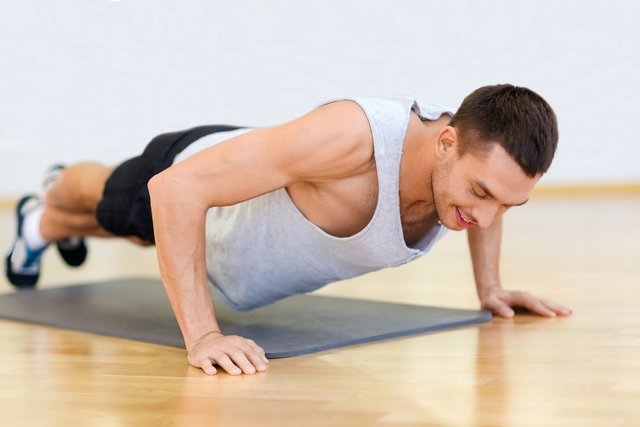Push-up is an exercise that mainly uses the pectoralis major muscles, triceps and deltoids, and can be indicated to strengthen, hypertrophy and improve control and/or function of the upper part of the body.
There are types or variations of the traditional push-up, also called arm push-up, such as the knee, shoulder or diamond push-up, which have varying levels of difficulty and can be included in different types of training. See an example of training to gain muscle mass.
It is important that push-ups are initially done with the guidance of a physical education professional so that all the necessary guidance is given to perform them correctly, in order to avoid injuries.

What is it for
Push-ups are recommended for:
- Strengthen the upper part of the body, especially the chest, shoulders and arms;
- Hypertrophy the pectoralis major muscles, triceps and deltoids;
- Improve balance and stability of the body;
- Recover control and function of the trunk and upper limbs.
The push-up is a great exercise for chest training and, as it uses different muscle groups, it can also be included in shoulder and/or arm training, for example. Find out how to do a chest workout at home.
Types of push-ups
The main types or variations of the push-up are:
1. Push-up
The arm push-up or traditional push-up is the simplest type of push-up that mainly works muscles in the chest, arms and shoulders. It is done with the hands resting on the floor, approximately shoulder-width apart, and the body aligned. Understand better what arm flexion is and how to do it.
2. Knee flexion
The knee push-up is a variation of the push-up that is done by resting your knees on the floor instead of your toes. It is more suitable for people who are starting to do push-ups, because you need to use less force to lift your body. Check out how to do the knee bend.
3. Shoulder flexion
It is a type of flexion that is done with the body in the position of an inverted “V”, meaning that the force must be exerted mainly with the shoulder muscles and triceps and, therefore, it is recommended for strengthening. See what shoulder flexion is for and how to do it.
4. Diamond push-up
The diamond push-up is a more advanced variation of the push-up that is done by placing your hands on the floor with the index fingers and thumbs of one hand touching those of the other. It is best suited for people who already do push-ups. Learn how to do the diamond push-up.
5. Nordic push-up
The Nordic push-up is a variation of the traditional push-up that is done with the knees and feet resting on the floor with the help of a support. The exercise begins with the torso elevated and the knees bent at a 90º angle, with the hands resting on the floor only at the end of the body’s descent.
6. Incline push-up
The incline push-up is an easier exercise compared to the traditional push-up that uses the help of a bench or elevation on which the hands are supported to ease the weight of the body on the arms. It’s a great type of push-up for beginners.
7. Military push-up
Although it is similar to a push-up, this type of push-up is done with the arms closer to the torso throughout the movement. It is recommended to especially strengthen the triceps and muscles on the side of the torso.
8. Decline push-up
The decline push-up is an exercise done with the toes resting on an elevation, causing more weight to be applied to the arms. It is a type of push-up more suitable for people who want more difficulty than traditional push-ups.
9. Open push-up
This type of push-up is a variation of the traditional push-up in which the main change is the greater distance between the hands, causing other muscle groups in the trunk to be used to exert force.
10. Archer push-up
The archer push-up is a type of push-up that allows you to train each side of the torso with greater intensity than traditional push-ups, using each arm alternately to do the push-ups. While one arm flexes, the other is used only for support.
Benefits of Push-Up
The main benefits of push-ups are:
- Can be done anywhere, not requiring specific gym equipment;
- It has many variations, being an exercise that can be adapted to each person’s physical conditioning and goals;
- Work different muscles at the same time, such as the pectorals, deltoids, triceps, glutes and abdomen.
However, it is important to consult a physical educator to find out which types of push-ups are best for each person and learn how to do the movements correctly to reduce the risk of injury.
How to do push-ups
The step by step to do the push-up is as follows:
- Kneel on the floor or on a rug of exercises;
- Place your hands on the floor at a distance slightly greater than shoulder width, with fingers facing forward and elbows facing back;
- Stretch your legs backforming a straight line with the body from head to toe;
- Put your feet togetherwho must only touch the floor with their fingers;
- Keep your shoulders above your wrists. This is the starting position, which is known as plank;
- Bend your elbows, keeping them close to your torsoto descend slowly with the body;
- Lower your body until your chest is close to the floorbut without touching it.
- Raise the body until it returns to the starting positionpushing the floor with your hands;
- Repeat the movement from the starting position.
During the exercise, the abdomen and glutes must be contracted to prevent the body from bending over. Furthermore, when bending the elbows, the arm must be at an angle of approximately 45º with the torso to avoid overloading the shoulders.
Although it is a simple exercise, it is important that push-ups are initially done with the guidance of a professional, to perform the movement correctly and avoid injuries.

Sign up for our newsletter and stay up to date with exclusive news
that can transform your routine!
Warning: Undefined array key "title" in /home/storelat/public_html/wp-content/plugins/link-whisper-premium/templates/frontend/related-posts.php on line 12
Warning: Undefined array key "title_tag" in /home/storelat/public_html/wp-content/plugins/link-whisper-premium/templates/frontend/related-posts.php on line 13



